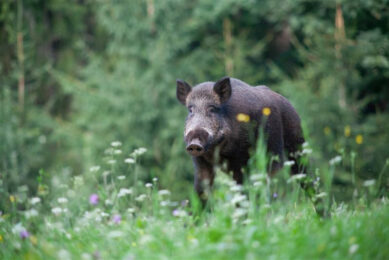Compensatory growth
One of the main arguments in using low quality or low density feeds for nursery and growing-finishing pigs is that late-life compensatory growth (when feed gets cheaper) will make up for any checks on early growth. So, is this true? Does compensatory growth really exist? The answer is a bit complicated.
One of the main arguments in using low quality or low density feeds for nursery and growing-finishing pigs is that late-life compensatory growth (when feed gets cheaper) will make up for any checks on early growth. So, is this true? Does compensatory growth really exist? The answer is a bit complicated.
In theory, compensatory growth does exist! It is a natural response of an organism deprived of its growth potential to improve its status once nutrient supply becomes abundant. But, for this to happen, that is to catch up, two factors are required.
- First, the organism must be seriously deprived of nutrients so that this basic survival mechanism is triggered. Mild deprivations only delay growth!
- Second, time is needed for the animal to compensate for any lost potential, especially if the losses were in muscle protein and the animal already grows close to its genetic potential for protein deposition. And, time is one thing we don’t really have with market pigs.
Think about it. When we market most pigs at six months of age, more or less, these animals are still immature and growing. If they were growing, as they should, close to their genetic potential, then there was little chance for any compensatory growth to make up for previously lost potential.
So, what happens in reality?
Research has proven that rapidly growing pigs do not have enough time to compensate for lost potential in lean muscle. Instead, they deposit fat, for which they have a huge potential (!), increase organ weight, and of course, increase their gut fill.
Research has proven that rapidly growing pigs do not have enough time to compensate for lost potential in lean muscle. Instead, they deposit fat, for which they have a huge potential (!), increase organ weight, and of course, increase their gut fill.
This is especially true for growing-finishing pigs (30-120 kg live weight). Seriously deprived piglets not only do they not recover any lost potential, but any setbacks early in life have negative carry-over effects during the growing-finishing period. Not to mention the huge health risks such piglets face when they are not growing/eating adequately.
Reports in Europe of compensatory growth
But, what about recent reports from Europe in which pigs appear to exhibit compensatory growth?
But, what about recent reports from Europe in which pigs appear to exhibit compensatory growth?
First, in most of these reports pigs were limit-fed to begin with, so when they were allowed ad libitum access to feed (after a mild deprivation period), they naturally increased their feed intake resulting in an ‘apparent’ compensatory growth.
In other reports, pigs were first offered a diet with a lower nutrient density than usual and then, they were switched to diets with a normal nutrient density. It was inferred that as pigs did not grow less than positive control pigs, the treated pigs must have exhibited some compensatory growth.
Of course, this is not accurate as it is most likely that to begin with, pigs did not need the higher nutrient density diets! This is especially true in areas where pigs don’t grow close to their potential due to adverse climatic conditions and/or long tradition in feeding imbalanced (cheap) diets fortified only in some nutrients (for example, high lysine but low in other essential amino acids).
To summarise:
Compensatory growth exists, but it is very unlikely to offer any real benefits during the short life-span of a growing-finishing pigs. Attempts to benefit from compensatory growth in nursery pigs almost invariably result in negative effects in later life.
Compensatory growth exists, but it is very unlikely to offer any real benefits during the short life-span of a growing-finishing pigs. Attempts to benefit from compensatory growth in nursery pigs almost invariably result in negative effects in later life.
Recent technical reports and observation trials published in magazines should be evaluated carefully as they contradict previous scientific work published in accredited journals. It is my recommendation that it is better to balance diets and match them with the needs of pigs instead of treading in the murky waters of compensatory growth debate!











